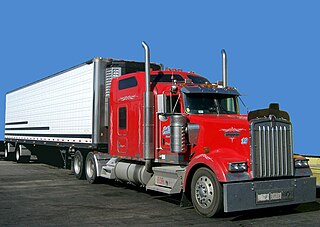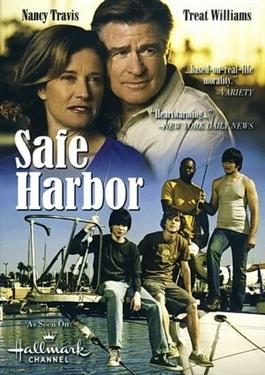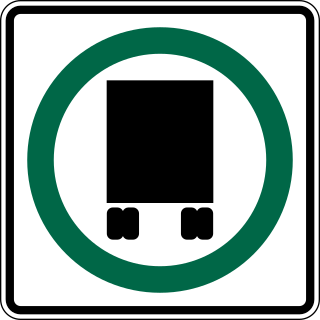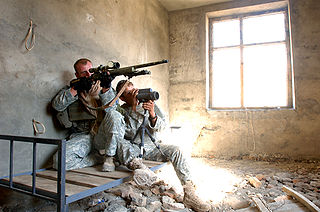
A semi-trailer truck, is the combination of a tractor unit and one or more semi-trailers to carry freight. A semi-trailer attaches to the tractor with a type of hitch called a fifth wheel.

Bomb disposal is an explosives engineering profession using the process by which hazardous explosive devices are disabled or otherwise rendered safe. Bomb disposal is an all-encompassing term to describe the separate, but interrelated functions in the military fields of explosive ordnance disposal (EOD) and improvised explosive device disposal (IEDD), and the public safety roles of public safety bomb disposal (PSBD) and the bomb squad.

A concept car is a car made to showcase new styling or new technology. Concept cars are often exhibited at motor shows to gauge customer reaction to new and radical designs which may or may not be mass-produced. General Motors designer Harley Earl is generally credited with inventing the concept car, and did much to popularize it through its traveling Motorama shows of the 1950s.

A safe is a secure lockable enclosure used for securing valuable objects against theft or fire. A safe is usually a hollow cuboid or cylinder, with one face being removable or hinged to form a door. The body and door may be cast from metal or formed out of plastic through blow molding. Bank teller safes typically are secured to the counter, have a slit opening for dropping valuables into the safe without opening it, and a time-delay combination lock to foil thieves. One significant distinction between types of safes is whether the safe is secured to a wall or structure or if it can be moved around.

A commercial driver's license (CDL) is a driver's license required in the United States to operate large and heavy vehicles or a vehicle of any size that transports hazardous materials or more than 15 passengers.

Safe-cracking is the process of opening a safe without either the combination or the key.

A mine countermeasures vessel or MCMV is a type of naval ship designed for the location of and destruction of naval mines which combines the role of a minesweeper and minehunter in one hull. The term MCMV is also applied collectively to minehunters and minesweepers.

A semi-trailer is a trailer without a front axle. The combination of a semi-trailer and a tractor truck is called a semi-trailer truck.

In road transport, an oversize load is a load that exceeds the standard or ordinary legal size and/or weight limits for a truck to convey on a specified portion of road, highway, or other transport infrastructure, such as air freight or water freight. In Europe, it may be referred to as special transport or heavy and oversized transportation. There may also be load-per-axle limits. However, a load that exceeds the per-axle limits but not the overall weight limits is considered overweight. Examples of oversize/overweight loads include construction machines, pre-built homes, containers, and construction elements.
The International Registration Plan (IRP) is a truck registration reciprocity agreement between the contiguous United States and Canadian provinces that provides apportioned payments of registration fees, based on the total distance operated in participating jurisdictions, to them. IRP's fundamental principle is to promote and encourage use of the highway system.

The Sasol Solar Challenge is a South African endurance challenge for solar-powered vehicles, with classes for hybrid vehicles, electric vehicles, and biofuel-powered vehicles as well. Recognised by the International Solarcar Federation, the first challenge was run in 2008, and every two years thereafter. The event covers roughly 2,500 km, but has set loops for teams to repeat, with the potential to do 5,000 km. The current record, held by Dutch team Nuon, is 4,716 km, set in 2016 in their car Nuna. The challenge route may change from year to year. In 2022, it ran from Carnival City near Johannesburg to Cape Town over the course of 8 days. The challenge has both local South African teams from both high schools and universities participate, as well as some top-ranking international teams from Japan (Tokai), Belgium and the Netherlands.
Operation Thunderhead was a highly classified combat mission conducted by U.S. Navy SEAL Team One and Underwater Demolition Team 11 (UDT-11) in 1972. The mission was conducted off the coast of North Vietnam during the Vietnam War to rescue two U.S. airmen said to be escaping from a prisoner of war prison in Hanoi. The prisoners, including Air Force Colonel John A. Dramesi were planning to steal a boat and travel down the Red River to the Gulf of Tonkin.

Safe Harbor is a 2009 television film, based on a true story starring Treat Williams and Nancy Travis. The film was first shown on Hallmark Channel on May 30, 2009.

The National Network is a network of approved state highways and interstates for commercial truck drivers in the United States. The Surface Transportation Assistance Act of 1982 authorized the establishment of a national network of highways designated for use by large trucks. On these highways, Federal width and length limits apply. The National Network (NN) includes almost all of the Interstate Highway System and other, specified non-Interstate highways. The network comprises more than 200,000 miles (320,000 km) of highways.

A hunter-killer team is a team that separates the tasks of "hunting" and "killing" to two or more individuals.

Drug-impaired driving, or drug driving, in the context of its legal definition, is the act of driving a motor vehicle while under the influence of an impairing substance. DUID, or Driving Under the Influence of Drugs, is prohibited in many countries. Several American states and European countries now have "per se" DUID laws that presume a driver is impaired if they are found to have any detectable quantity of controlled substances in their body while operating an automobile and that the driver has no doctor's prescription for the substance. This is similar to the "per se" DUI/DWI laws that presume a driver is impaired when their blood alcohol content is above a certain level. There is some controversy with "per se" DUID laws in that a driver with any detectable quantity of controlled substances may not in fact be impaired and the detectable quantity in blood or sweat may be only the remnants of drug use in days or weeks past. It is against road traffic safety. Research on factors associated with engaging in DUID is receiving increasing attention to develop more effective countermeasures.

Spirit of Berlin was a driverless car developed by the Freie Universität Berlin, Germany.

Keiler mine flail is a mine-clearing vehicle developed by Rheinmetall in Germany to meet the requirements of the German Army. It is a conversion of the M48 Patton medium tank chassis in combination with a German MTU MB 871 Ka 501 liquid-cooled turbocharged Diesel engine. The main role of the Keiler vehicle is to clear a lane through minefields to ensure the safe passage of soldiers and vehicles. A deployable mine flail system has been fixed to the front of the vehicle, which is used to clear both anti-tank and anti-personnel mines. Between 1997 and 1998, 24 vehicles of this kind were produced for the German Army.
The GlobalNew Car Assessment Programme is a project of the Towards Zero Foundation, a UK-registered charity. The programme serves as an umbrella organisation encouraging co-operation between the various New Car Assessment Programmes around the world, and supports campaigns to inform consumers about the safety of vehicles in markets that are weakly regulated or do not yet have their own consumer safety programmes.















